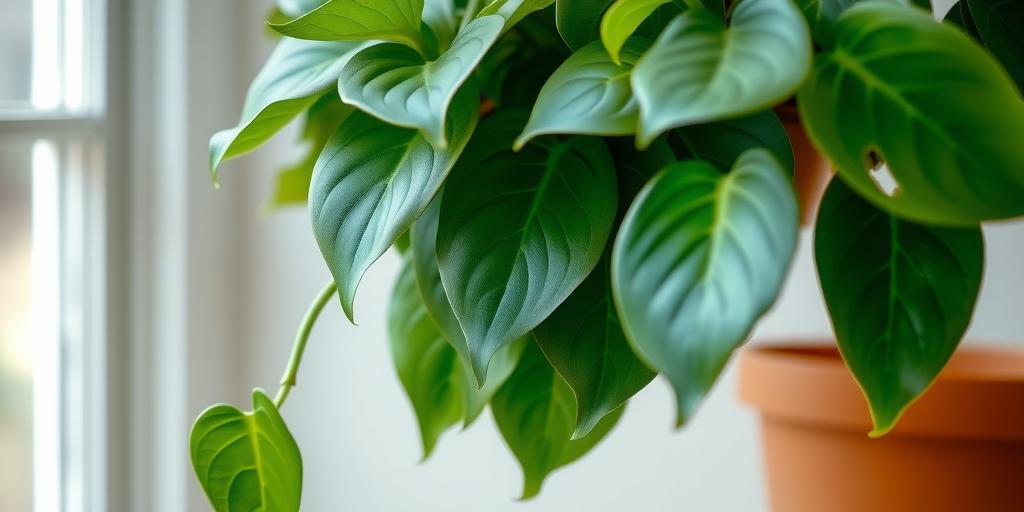
Complete Guide to Satin Pothos Care for Hanging Plants (2025)
Learn how to care for your satin pothos hanging plant with this complete guide! Discover lighting, watering, propagation tips, and more to keep your Scindapsus pictus thriving.
Introduction
Did you know the satin pothos (Scindapsus pictus) is one of the most popular trailing houseplants? Its silvery, heart-shaped leaves add a touch of elegance to any space, especially when displayed in hanging baskets. But how do you keep it lush and healthy? Whether you’re a beginner or a seasoned plant parent, this guide covers everything—from ideal lighting conditions to troubleshooting common issues. Let’s dive in!
What Is a Satin Pothos?
Satin pothos, scientifically known as Scindapsus pictus, is a stunning tropical plant often mistaken for a true pothos (like the golden pothos). But while they share similarities, they’re actually different species. You might also hear it called silver pothos or silk pothos due to its gorgeous, shimmering foliage.
This plant is native to Southeast Asia, where it thrives in warm, humid environments. Its most striking feature? Those heart-shaped leaves splashed with silvery-gray variegation. Unlike golden pothos, which has yellow streaks, satin pothos has a more subtle, metallic sheen.
Another key difference is its growth habit—satin pothos tends to grow a bit slower and has a more compact trailing form, making it perfect for hanging baskets or climbing up a moss pole.
Ideal Growing Conditions for Satin Pothos
Light Requirements
Satin pothos loves bright, indirect light—think near an east or north-facing window where it gets plenty of filtered sunlight. While it can tolerate lower light, its variegation will fade if it’s too dark. On the flip side, direct sun can scorch those delicate leaves, so keep it out of harsh afternoon rays.
Temperature & Humidity
This tropical beauty thrives in temperatures between 65°F and 85°F (18°C–29°C). It’s not frost-tolerant, so keep it away from cold drafts in winter. Humidity is also a big deal—aim for 40–60% to keep it happy. If your air is dry, try misting the leaves, using a pebble tray, or placing a humidifier nearby.
Soil Preferences
A well-draining mix is key to preventing root rot. A blend of peat moss, perlite, and orchid bark works great. You can also use a standard indoor potting mix with extra perlite for aeration. The goal? Soil that holds moisture but doesn’t stay soggy.
Watering Your Satin Pothos Correctly
Overwatering is the #1 killer of satin pothos. To avoid this, let the top 1–2 inches of soil dry out before watering again. Stick your finger in the soil—if it feels dry, it’s time to water.
Signs of Overwatering
-
Yellow leaves (especially lower ones)
-
Mushy stems
-
A foul smell from the soil (hello, root rot!)
Signs of Underwatering
-
Curling leaves
-
Dry, crispy edges
-
Soil pulling away from the pot’s edges
When in doubt, underwatering is safer—satin pothos can bounce back from drought better than from drowning.
Fertilizing for Healthy Growth
For lush, vibrant leaves, feed your satin pothos with a balanced liquid fertilizer (like a 10-10-10 or 20-20-20 formula). During the growing season (spring and summer), fertilize once a month. In fall and winter, cut back—plants grow slower and need fewer nutrients.
Signs of Nutrient Deficiency
-
Pale or yellowing leaves
-
Slow or stunted growth
-
Small, weak new leaves
If you notice these, a light feeding can help. Just don’t overdo it—too much fertilizer can burn the roots.
Pruning and Training for Fuller Growth
Satin pothos can get leggy if left alone. To encourage bushiness, trim long vines just above a leaf node (the little bump where leaves grow). This prompts new growth from the base.
Training Techniques
-
Hanging baskets: Let the vines cascade naturally for a lush look.
-
Trellises or moss poles: Gently tie stems to support climbing growth.
Propagating Cuttings
Want more plants? Snip a 4–6 inch cutting below a node and place it in water or soil. Roots should appear in 2–4 weeks. Once roots are a few inches long, pot it up!
Common Pests & Problems
Identifying Pests
-
Spider mites: Tiny webs, yellow speckling on leaves.
-
Mealybugs: White, cottony clusters in leaf joints.
-
Scale: Hard, brown bumps on stems.
Natural Remedies
-
Neem oil (diluted and sprayed on leaves)
-
Insecticidal soap (for heavy infestations)
-
Wiping leaves with a damp cloth
Fixing Common Issues
-
Yellow leaves: Usually overwatering—check soil moisture.
-
Brown tips: Low humidity or too much fertilizer.
-
Drooping stems: Could be underwatering or root rot.
Repotting Your Satin Pothos
Satin pothos likes to be slightly root-bound, so repot every 1–2 years or when roots poke out of drainage holes.
Choosing the Right Pot
-
Size: Only go 1–2 inches larger than the current pot.
-
Material: Terracotta (breathable) or plastic (retains moisture longer).
Step-by-Step Repotting
-
Gently remove the plant from its pot.
-
Loosen the roots and trim any dead ones.
-
Place in fresh soil, filling gaps around the roots.
-
Water lightly and let it adjust in indirect light.
Styling Ideas for Hanging Displays
Satin pothos is a decor superstar—here’s how to show it off:
Best Hangers & Planters
-
Macramé hangers: Perfect for bohemian vibes.
-
Ceramic pots with drainage: Sleek and functional.
Plant Pairings
-
Philodendron Brasil (complementing variegation)
-
String of pearls (contrasting textures)
Creative Placement
-
Shelves: Let vines trail down for a living curtain.
-
Bathrooms: High humidity = happy pothos.
-
Office desks: Low-maintenance and uplifting.
With the right care, your satin pothos will be a showstopper in any space!
Conclusion
Caring for a satin pothos is easier than you think! With the right light, water, and occasional pruning, your hanging plant will thrive and add beauty to your space. Ready to expand your indoor jungle? Try propagating a cutting or experimenting with different hanging displays. Happy planting!
